What's New
Displaying results 4751 - 4760 of 4914
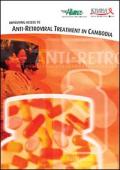
Resource | Publications,
Cambodia is often cited as an example of how an effective multi-sectoral response to HIV, with strong political commitment and effective co-operation between government, nongovernmental organisations (NGOs), and international organisations, can impact on the spread of infection. Cambodia has an HIV/AIDS prevalence of 2.6% in the adult population (15-49 years). Government data indicates that HIV prevalence rates in some of the populations under surveillance appear to be declining. However, the current data indicates that HIV/AIDS is not uniformly distributed throughout the country and numbers of cases of AIDS and AIDS-related deaths continue to increase.
This report, building on the strengths of Khmer HIV/AIDS NGO Alliance (KHANA) and its partners, focuses on the current and future opportunities for KHANA, and other NGOs, to support access to ARV treatment for people with HIV. Recommendations are given with regard to use of existing sources of ARV, sources for increasing availability of ARV, and models for provision of ARV most likely to bring broad benefits to patients, as well as to prevention efforts, and to the health system in general.
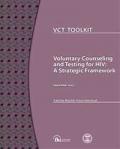
Resource | Tools,
The HIV epidemic continues to spread at an alarming rate, with over 14,000 new infections per day. While the epidemic is now spreading rapidly in some parts of Asia and Latin America and Caribbean, sub-Saharan Africa continues to bear the greatest burden of disease. HIV prevalence exceeds 30 percent among sexually active adults in some African cities, and AIDS is the leading cause of death in major cities within sub-Saharan Africa.

Resource | Publications,
With USAID funding Family Health International (FHI) launched a series of sexual behavior surveys in developing countries called Behavioral Surveillance Surveys (BSS). These repeated cross-sectional surveys of behaviors in sentinel groups are now considered as an essential component of second generation HIV surveillance systems. These surveys are designed to be administered on a regular basis (either annually or bi-annually) to provide data on changes of risk behaviors over time. Cambodia is fortunate to have one of the most comprehensive BSS in the world, established in 1997 and repeated annually. The 2001 BSS is the fifth round.
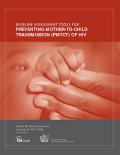
Resource | Tools,
Now that there are cheap and effective interventions to prevent mother-to-child transmission of HIV (PMTCT), programs are rapidly being planned and introduced to make these activities more widely available in developing countries. Implementing these programs requires understanding the quality and scope of existing MCH and maternity care services, as well as effective, continual monitoring and evaluation. The present assessments tools are designed to respond to this need.
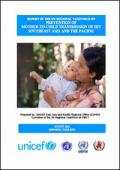
Resource | Publications,
UNICEF EAPRO convened the UN Regional Taskforce meeting in Bangkok from 27-29 August 2003 as part of ongoing efforts to support countries to respond strategically and effectively to HIV/AIDS, to share the lessons learned between countries and from clinical trials and programme initiatives, and to meet the Millennium Development Goals, and the Declaration of Commitments arising from the 2001 UN General Assembly Special Session on HIV/AIDS.
There were a total of 23 participants from nine countries and 10 resource persons from regional technical organizations.

Resource | Publications,
The HIV epidemic in Vietnam is growing, and promotion of prevention behavior among vulnerable populations, such as migrant workers, is becoming increasingly critical. In Ho Chi Minh City (HCMC), the locus of the epidemic in Vietnam, efforts have been under way for several years to implement prevention efforts for migrant worker populations.
Led by the HCMC AIDS Committee and HCMC Labor Union, the main activity has utilized volunteer health communicators (HC) to visit workplaces and conduct HIV education activities. However, these efforts have reached only a relatively small number of the intended audience, and the impact of the current program is unclear. Local authorities want to scale up their efforts but require information on the most effective and least costly activities, as well as their potential for scale up.
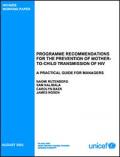
Resource | Guidelines,
This guide provides specific information for improving and scaling-up prevention of mother-to-child transmission of HIV (PMTCT) programs, based on what program managers and evaluators identify as successful strategies. The guide is intended for use by national-level PMTCT teams for starting or scaling up PMTCT programs. With appropriate adaptation, national officials can disseminate the guide to district level authorities, site managers, and health workers.
The recommendations in this guide draw on this body of knowledge, including primarily from an IATT-commissioned evaluation of the eleven pilot projects, carried out by the Population Council between March and December 2002 in close consultation with UNICEF and other Inter-Agency Task Team (IATT) members. Sources include progress reports from the country pilots, interviews, rapid assessments in Rwanda and Zambia and discussions at a collaborative analysis meeting held in December 2002.

Resource | Laws and Policies,
Being an Act to give effect to the Basic Rights acknowledged in Preamble to the Constitution, in particular the rights and freedoms of -
(a) life, liberty, security of the person and protection of the law; and
(b) freedom of inhuman treatment; and...
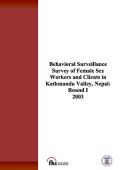
Resource | Publications,
This study was conducted among street and establishment-based female sex workers (FSWs) and their clients in Kathmandu. This is the first round of the Behavioral Surveillance Survey conducted among the two groups: FSWs and their clients in the Kathmandu Valley. The survey was carried out during the months of July and August 2001 to measure risk behaviors which are associated with the risk of HIV infection, such as condom use, sexual behaviors, knowledge of HIV/AIDS, reported cases of STI and their treatment behaviors, exposure to HIV/AIDS messages, and drug habits.
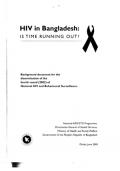
Resource | Publications,
For many years Bangladesh has been able to escape the HIV/AIDS epidemic that is affecting countries all around us. Now the results of the fourth round of national surveillance indicate that the country has no reason to be complacent. In the central part of the country, there is an upsurge of HIV infection among injection drug users. Fortunately, the virus has remained at low prevalence among the other vulnerable groups under surveillance.





